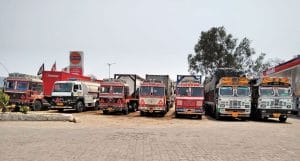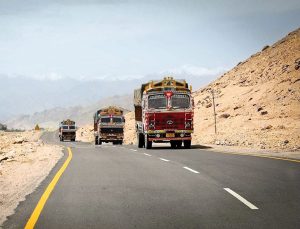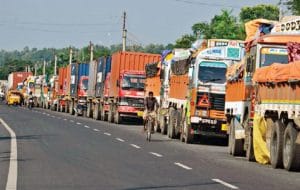 Madhav runs a fleet of four Tata Ace in Pune. He pilots one of the vehicles whereas the other three are piloted by his band of drivers. All the vehicles operate in the industrial belts in and around the city, ferrying industrial goods among others. The current lockdown in Pune in view of the spike Covid infections has affected Madhav’s ability to operate at full strength. All three of his drivers have gone to their homes. They hail from Bihar and Uttar Pradesh. Left with just one vehicle to operate, Madhav is experiencing a big drop in ultilisation levels. Over phone, he states the lack of drivers is hurting the business. But then, he quips, it is also the case that industries have seen a huge drop in their operations. The lockdown that was announced in the second half of April 2021 has had a negative effect on industrial productivity. Plants in the industrial belts aren’t working at full capacity and the flow of raw material as well as the finished goods has slowed down considerably. The shortage of oxygen has put paid to any efforts to their operating smoothly. As industries slow down and shops remain closed, except for essentials, fleets other than those in the e-commerce and a few other sectors like pharma, the road transport fraternity has come to feel the pain. Much like last year. This is in-turn reflecting on the economic and social environment. It is also signaling driver shortage in the coming months as fears of nation-wide lockdown erupt. Especially on the minds of those that have travelled thousands of kilometers from their homes to work.
Madhav runs a fleet of four Tata Ace in Pune. He pilots one of the vehicles whereas the other three are piloted by his band of drivers. All the vehicles operate in the industrial belts in and around the city, ferrying industrial goods among others. The current lockdown in Pune in view of the spike Covid infections has affected Madhav’s ability to operate at full strength. All three of his drivers have gone to their homes. They hail from Bihar and Uttar Pradesh. Left with just one vehicle to operate, Madhav is experiencing a big drop in ultilisation levels. Over phone, he states the lack of drivers is hurting the business. But then, he quips, it is also the case that industries have seen a huge drop in their operations. The lockdown that was announced in the second half of April 2021 has had a negative effect on industrial productivity. Plants in the industrial belts aren’t working at full capacity and the flow of raw material as well as the finished goods has slowed down considerably. The shortage of oxygen has put paid to any efforts to their operating smoothly. As industries slow down and shops remain closed, except for essentials, fleets other than those in the e-commerce and a few other sectors like pharma, the road transport fraternity has come to feel the pain. Much like last year. This is in-turn reflecting on the economic and social environment. It is also signaling driver shortage in the coming months as fears of nation-wide lockdown erupt. Especially on the minds of those that have travelled thousands of kilometers from their homes to work. 
It is no secret that many commercial vehicle drivers have migrated thousands of kilometers to work. That, they have left their families at home. The case of Madhav’s three drivers for example. In the case of heavy vehicle drivers, the situation could be a little different, mentions an industry source. He draws attention to measures taken by fleets to retain their drivers before expressing that the sudden change in atmosphere after a few months of demand rebound and a slow walk to normacly seems to play on the minds of all the people. Drivers clearly are not immune to that, he adds. In a situation were security seems to be at stake, even the provision of better driving and boarding conditions will not suffice, mentions another source. It will help to an extent, but not beyond, he quips. Interestingly, the recent annual driver shortage survey by IRU announces that driver shortage will soar in 2021. It is based on a survey sample of 800 road transport companies across 20 countries. Citing that China fares better with four-per cent jobs open among the 20 countries involved, the survey points at driver shortage across truck and bus segments in 2021.
Shortage of CV drivers?
Shortage of commercial vehicle drivers in India is no secret. How bad it is, is also not a secret. Neither is the lack of professional drivers. Mentions the source, driver shortage in April 2021 and May 2021 was high as many chose to return to their families. Many operators also laid them off temporarily in anticipation of falling utilisation levels, he  adds. If the change in axle norms in 2018 and the economic slowdown of 2019 affected the road transport fraternity, the first Covid wave proved to be the last straw on the camel’s back for many. The transition to BSVI and the subsequent jump in new vehicle prices did not help either. The announcement of scrappage policy brought another round of rethink in the road transport fraternity. The effect of the regulatory measures, starting from the transition to BSIV have been immense. How they boil down to the generation of new drivers or driver shortage is not clear yet. Especially from the point of view the machines turning modern and more comfortable to drive. Some are of the opinion that application-based higher tonnage trucks will help mitigate driver shortage whereas some are of the opinion that driver shortage will get worse as normalcy returns to the trade.
adds. If the change in axle norms in 2018 and the economic slowdown of 2019 affected the road transport fraternity, the first Covid wave proved to be the last straw on the camel’s back for many. The transition to BSVI and the subsequent jump in new vehicle prices did not help either. The announcement of scrappage policy brought another round of rethink in the road transport fraternity. The effect of the regulatory measures, starting from the transition to BSIV have been immense. How they boil down to the generation of new drivers or driver shortage is not clear yet. Especially from the point of view the machines turning modern and more comfortable to drive. Some are of the opinion that application-based higher tonnage trucks will help mitigate driver shortage whereas some are of the opinion that driver shortage will get worse as normalcy returns to the trade.
Lack of respect?
 Stating that the lack of respect and harrasment by authorities is turning out to be the main reason for many desisting from taking up the profession. So, the emergence of drivers as a gradual upliftment of a spotter continues to an extent even today. If a fleet would want to invest in driver training? The advent of BSVI trucks and the change in operating economics has paved the way to an extent, says a source. However, there’s more that can be done to address the issue of driver shortage, he mentions. Expresses a mid-size transporter from Indore over phone. He is finding it tough to sustain on the basis of the rising costs of doing business. He points at the high fuel prices, rising consumable prices and the high compliance costs. At the other end, he says, business has dropped significantly and freight rates are not very conducive. Incidently, the freight rates on trunk routes have shot up primarly due to the less availability of trucks lately! On the issue of driver shortage, he says that since the utilisation levels are low, he is managing. States another transporter from Hubbali that the shift in operating economics has made it necessary for him to acquire a truck costing between Rs.45 and Rs.50 lakh. The way the business is turning out to be, it is not giving him enough confidence to acquire a machine of such cost. He is make doing with what he has. Luckily on the driver front he is managing to handle a certain attrition rate.
Stating that the lack of respect and harrasment by authorities is turning out to be the main reason for many desisting from taking up the profession. So, the emergence of drivers as a gradual upliftment of a spotter continues to an extent even today. If a fleet would want to invest in driver training? The advent of BSVI trucks and the change in operating economics has paved the way to an extent, says a source. However, there’s more that can be done to address the issue of driver shortage, he mentions. Expresses a mid-size transporter from Indore over phone. He is finding it tough to sustain on the basis of the rising costs of doing business. He points at the high fuel prices, rising consumable prices and the high compliance costs. At the other end, he says, business has dropped significantly and freight rates are not very conducive. Incidently, the freight rates on trunk routes have shot up primarly due to the less availability of trucks lately! On the issue of driver shortage, he says that since the utilisation levels are low, he is managing. States another transporter from Hubbali that the shift in operating economics has made it necessary for him to acquire a truck costing between Rs.45 and Rs.50 lakh. The way the business is turning out to be, it is not giving him enough confidence to acquire a machine of such cost. He is make doing with what he has. Luckily on the driver front he is managing to handle a certain attrition rate. 
With vehicle utilisation levels lower than before, the shortage of drivers may not be felt as much by many transporters. However, predicts the industry source, it will be felt when the demand robounds. This, he adds, could be in FY2022-23 as the country drives out of the shadow of Covid whose second wave is currently creating havoc. Anticipates IRU Secretary General Umberto de Pretto, “As economies recover and demand for transport services increases, driver shortage threatens the functioning of road transport, supply chains, trade, economy and eventually employment and citizens’ welfare.” A Mumbai-based transporter, into supply of raw material to industries on the outskirts, is of the opinion that working in this front-line, essential position throughout the COVID-19 pandemic has been challenging for his drivers. Despite much call for help by the drivers (and fleet owners for their drivers to be given a health cover) who risked their lives during the first wave last year to keep the supply chain from collapsing, the government has done little, he rues. States another Mumbai-based transporter on the condition that his name should not be disclosed, that the government turned its back to the drivers of commercial vehicles who kept the nation’s supply chain from collapsing. The government did not even bother to heed to the prayers of helping the transport fraternity get back on its feet after a two month hiatus, he avers. About driver shortage, he is currently managing he says with the utilisation levels low and the business down.
A reluctant youth?
With the youth not keen to take up the job of a commercial vehicle driver, the average age of the driver is fast growing. Most long-haul truck drivers are above the age of 35, states an industry source. Sometime back, there was a talk of uneducated people being granted a license subject to scientific driver training. The IRU report states the  average age of professional truck drivers globally is now close to 50. It is steadily growing older each year, it highlights. It also forecasts that this demographic time bomb will only get worse without action to reduce minimum driver age. Pointing at unemployment numbers, a fleet manager in India quips that the lack of respect is a big inhibitor. He also speaks of social constraints like the refusal of families to marry their daughter to a truck driver. Despite being well-paid, the number of new long-haul drivers continues to be scarce because of the reluctance to stay away from the family for an extended period, the manager adds. Interestingly, the IRU report puts the minimum age for professional drivers at 21 or higher in many countries that it surveyed. This creates a large gap between leaving school and taking the wheel.
average age of professional truck drivers globally is now close to 50. It is steadily growing older each year, it highlights. It also forecasts that this demographic time bomb will only get worse without action to reduce minimum driver age. Pointing at unemployment numbers, a fleet manager in India quips that the lack of respect is a big inhibitor. He also speaks of social constraints like the refusal of families to marry their daughter to a truck driver. Despite being well-paid, the number of new long-haul drivers continues to be scarce because of the reluctance to stay away from the family for an extended period, the manager adds. Interestingly, the IRU report puts the minimum age for professional drivers at 21 or higher in many countries that it surveyed. This creates a large gap between leaving school and taking the wheel.
Professional training schools have emerged on the scene with CV manufacturers like Ashok Leyland and Volvo taking the lead. How much have these helped? Yes, mentions a source. If they have been able to pull a good amount of youth as a means of employment? The answer is a ‘yes’ and ‘no’. He explains: “The youth is simply reluctant to take up the job of a CV driver because it lacks respect and is subject to much harrasment. He pints at instances being widely reported last year. Despite permission, drivers were harrased by authorities and others despite rendering essential services. With no eateries or boarding facilities operating, they were subjected to much inconvenience and anguish as the state borders closed and Section 144 was imposed. Highlighted the source that poor treatment at delivery sites and temporary border controls, it is clear, isn’t helping either. Long-haul drivers, the he avers, are growing scarce not because they are not getting paid well, it is because they do not enjoy good working conditions in terms of respect, boarding and security.
 Announces the IRU report: More investment in safe and secure truck parking areas to fix the current massive global shortfall would make long-haul driver conditions safer and get more people behind the wheel. The report also stresses on training and certification as a vital medium to attract and develop skilled drivers, especially with new technology, safety expectations and compliance standards. Yet another important point the IRU report raises is the need for governments to act. Says Umberto, “If governments do not act now to ease access to profession, improve working conditions and upskill the workforce, driver shortage will continue to disrupt and eventually irreparably damage vital mobility networks and supply chains.”
Announces the IRU report: More investment in safe and secure truck parking areas to fix the current massive global shortfall would make long-haul driver conditions safer and get more people behind the wheel. The report also stresses on training and certification as a vital medium to attract and develop skilled drivers, especially with new technology, safety expectations and compliance standards. Yet another important point the IRU report raises is the need for governments to act. Says Umberto, “If governments do not act now to ease access to profession, improve working conditions and upskill the workforce, driver shortage will continue to disrupt and eventually irreparably damage vital mobility networks and supply chains.”



















